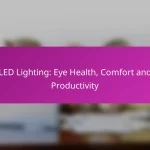LED lighting solutions provide a cost-effective and durable alternative to traditional lighting options. With their energy efficiency and long lifespan, these systems not only lower energy consumption but also minimize maintenance costs, making them ideal for both residential and commercial use. By choosing LED technology, users can enjoy significant savings while contributing to a more sustainable environment.

What are the cost-effective LED lighting solutions in the UK?
Cost-effective LED lighting solutions in the UK include energy-efficient bulbs, smart LED systems, commercial LED fixtures, and LED retrofitting options. These solutions not only reduce energy consumption but also offer long-lasting durability, making them a practical choice for both residential and commercial applications.
Energy-efficient bulbs
Energy-efficient LED bulbs are designed to consume significantly less electricity compared to traditional incandescent or halogen bulbs. They typically use around 75% less energy and last up to 25 times longer, resulting in lower electricity bills and reduced replacement costs.
When selecting energy-efficient bulbs, consider the brightness (measured in lumens) and the color temperature (measured in Kelvin) to ensure they meet your lighting needs. Look for bulbs with Energy Star certification for guaranteed efficiency and performance.
Smart LED systems
Smart LED systems integrate advanced technology to enhance lighting control and efficiency. These systems allow users to adjust brightness, color, and timing through smartphone apps or voice commands, contributing to energy savings and convenience.
Investing in smart LED solutions can lead to significant cost reductions over time, especially when combined with motion sensors and timers. Ensure compatibility with your existing home automation systems for seamless integration.
Commercial LED fixtures
Commercial LED fixtures are designed for larger spaces such as offices, warehouses, and retail environments. They provide high-quality illumination while minimizing energy use, making them ideal for businesses looking to cut operational costs.
When choosing commercial LED fixtures, consider factors such as lumen output, fixture type (e.g., panel, troffer, or high bay), and installation requirements. Many fixtures are available with dimming options, which can further enhance energy savings.
LED retrofitting options
LED retrofitting involves replacing traditional lighting components with LED technology without the need for a complete overhaul. This approach is often more cost-effective than installing new fixtures and can significantly improve energy efficiency.
Common retrofitting options include LED tubes for fluorescent fixtures and LED retrofit kits for recessed lighting. Before retrofitting, assess compatibility with existing fixtures and ensure compliance with local regulations to maximize benefits.

How do LED lights compare in durability?
LED lights are known for their exceptional durability compared to traditional lighting options. They typically last significantly longer and are built to withstand various environmental factors, making them a reliable choice for both residential and commercial use.
Long lifespan of LED bulbs
LED bulbs can last anywhere from 15,000 to 50,000 hours, far exceeding the lifespan of incandescent and fluorescent bulbs. This longevity means fewer replacements and lower maintenance costs over time.
When choosing LED bulbs, consider the quality of the product, as higher-quality LEDs tend to have longer lifespans. Look for bulbs that meet recognized standards, such as Energy Star certification, to ensure durability.
Resistance to shock and vibration
LED lights are inherently more resistant to shock and vibration than traditional bulbs due to their solid-state construction. This makes them ideal for use in environments where movement or impact is common, such as in vehicles or industrial settings.
For applications that require high durability, such as outdoor lighting or in areas prone to rough handling, selecting LED options designed for rugged conditions can further enhance performance and lifespan.

What are the benefits of using LED lighting?
LED lighting offers numerous advantages, including significant energy savings, lower maintenance costs, and a reduced environmental footprint. These benefits make LEDs a smart choice for both residential and commercial applications.
Lower energy bills
One of the primary benefits of LED lighting is its ability to lower energy bills. LEDs consume significantly less electricity compared to traditional incandescent or fluorescent bulbs, often using up to 80% less energy. This reduction translates into noticeable savings on monthly utility costs.
For example, replacing a standard 60-watt incandescent bulb with a 10-watt LED can save approximately $100 or more over the bulb’s lifespan, depending on local electricity rates. This makes LEDs an economically sound investment for long-term use.
Reduced maintenance costs
LED lights have a much longer lifespan than traditional lighting options, often lasting 15,000 to 50,000 hours. This longevity means fewer replacements and lower maintenance costs over time. Businesses and homeowners can save on labor and materials associated with frequent bulb changes.
Additionally, many LED fixtures are designed for durability, making them less prone to breakage. This resilience further contributes to reduced maintenance expenses, especially in high-traffic or hard-to-reach areas.
Environmental impact
Using LED lighting significantly reduces environmental impact due to lower energy consumption and longer lifespans. Since LEDs require less electricity, they contribute to decreased greenhouse gas emissions from power plants. This is particularly relevant in regions where fossil fuels are the primary energy source.
Moreover, LEDs contain no toxic materials like mercury, which is found in some traditional bulbs. This makes them safer for disposal and reduces the risk of environmental contamination. By choosing LED lighting, consumers can make a positive contribution to sustainability efforts.

What factors affect the cost of LED lighting?
The cost of LED lighting is influenced by several factors, including the initial purchase price, installation costs, and long-term savings. Understanding these components can help consumers make informed decisions about their lighting investments.
Initial purchase price
The initial purchase price of LED lights can vary significantly based on brand, wattage, and features. On average, a standard LED bulb may cost between $5 to $15, while specialized fixtures can range from $30 to several hundred dollars. Investing in higher-quality products often leads to better performance and longevity.
Installation costs
Installation costs for LED lighting can depend on the complexity of the setup and whether professional help is required. Simple replacements of existing bulbs can be done at no cost, while retrofitting fixtures or installing new systems may incur expenses ranging from $100 to $500 or more. It’s essential to factor in these costs when budgeting for LED lighting upgrades.
Long-term savings
One of the most significant advantages of LED lighting is its long-term savings potential. LEDs consume significantly less energy than traditional incandescent or fluorescent bulbs, often reducing electricity bills by 50% or more. Additionally, their lifespan can exceed 15,000 hours, meaning fewer replacements and lower maintenance costs over time.

How to choose the right LED lighting for your needs?
Choosing the right LED lighting involves understanding your specific requirements for brightness, color temperature, and fixture compatibility. By assessing these factors, you can select the most suitable LED solutions for your space and activities.
Assessing brightness requirements
Brightness in LED lighting is measured in lumens. For general home use, aim for around 800 lumens for a standard bulb, while task lighting may require upwards of 1,500 lumens. Consider the size of the room and the activities performed to determine the appropriate brightness level.
As a rule of thumb, living areas need lower brightness compared to workspaces. For example, a living room may require about 100-200 lumens per square meter, while a kitchen or office may need 300-500 lumens per square meter. Adjust your choices based on personal preference and the specific tasks at hand.
Understanding color temperature
Color temperature, measured in Kelvin (K), affects the ambiance of a space. Warm white light (2700K-3000K) creates a cozy atmosphere, ideal for living rooms and bedrooms, while cool white light (4000K-5000K) is better suited for workspaces and kitchens where clarity is essential.
When selecting LED lights, consider the mood you want to create. For example, a warm light is inviting for relaxation, while a cooler light enhances focus. Many LED products now offer adjustable color temperatures, providing flexibility for different settings.
Evaluating fixture compatibility
Before purchasing LED lights, check the compatibility with existing fixtures. Ensure the wattage and size of the LED bulb match your current sockets, and consider whether the fixture is designed for dimmable LEDs if you require that feature.
Some fixtures may not be suitable for LED bulbs due to heat dissipation issues or design constraints. If replacing incandescent bulbs, look for LED options that are specifically labeled as compatible with your fixtures to avoid flickering or performance issues.


